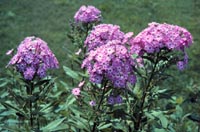Resource Library
Plant of the Week: Phlox, Garden
The University of Arkansas System Division of Agriculture does not promote, support or recommend plants featured in "Plant of the Week." Please consult your local Extension office for plants suitable for your region.
Plant of the Week
Garden Phlox
Latin: Phlox paniculata

Perennials are definitely in with gardeners.
Perennials are seen as good garden investments because they yield dividends over
the years to come, not just the current season as we see with annuals. One of the
first native American perennials to gain super star status in the garden was the garden
phlox.
The garden phlox is a native plant found in open woodlands from upstate New York
across to Michigan and down to Arkansas and Tennessee.
Garden phlox is a 3- to 4-foot tall perennial that will form clumps 2 or more feet
across. In early to mid-summer the ends of each stem are covered with a mass of tubular
five-petaled blooms in a large panicle. Individual blooms are about an inch across
and come in shades of lavender, pink, carmine, red, white and bi-colors.
It was not until the 1740s that John Bartram, America’s foremost colonial-era plantsman,
introduced it to his English counterpart -- Peter Collinson. Once in England the plant
became popular in estate gardens, but it was not until the 1850s that the garden phlox
began to become popular with the English middle class. This happened as the industrial
revolution saw more leisure time develop for the working middle class. To occupy this
time, gardening became more popular than ever.
European selections of our native garden phlox began being offered in Boston in 1837
when the seedsman Joseph Breck began selling plants. This is but one of a long list
of native American plants that were first championed in a foreign land and then introduced
back to our gardens as "new" plants.
The plant remained popular until the 1930s when changing fashions in garden design
and the hype created by the introduction of hybrid annuals by companies such as Burpee
moved perennials to a second class stature. After a fleeting revival in interest during
the 1950s, garden phlox remained in the background until the revival in interest in
perennials that occurred in the 1990s.
There are about 50 selections and hybrids of the garden phlox in the trade -- some
of these are good tough plants and some are dogs. Here at the University of Arkansas,
we are gearing up for a trial of as many phlox cultivars as we can test. We are especially
interested in identifying selections that tolerate our heat and humidity and not develop
a terminal case of powdery mildew. This fungus disease is a problem with many cultivars
and has made some gardeners gun shy about using the plant.
Garden phlox does best in full sun in a good, fertile soil that is well-watered but
never soggy. Plants should be given plenty of room in the perennial border because
3-year-old plants can form clumps two feet across.
To keep plants from becoming overly crowded, the clump should be divided every three
or four years in the spring before new growth starts. After blooming it is a good
idea to trim flower heads off to prevent reseeding in the garden.
By: Gerald Klingaman, retired
Extension Horticulturist - Ornamentals
Extension News - July 16, 1999
The University of Arkansas System Division of Agriculture does not maintain lists of retail outlets where these plants can be purchased. Please check your local nursery or other retail outlets to ask about the availability of these plants for your growing area.